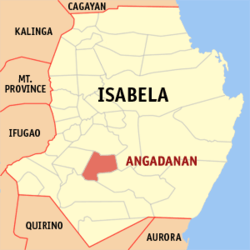Angadanan, Isabela
Angadanan, officially the Municipality of Angadanan (Ilocano: Ili ti Angadanan; Tagalog: Bayan ng Angadanan; or Angadanan Nuevo), is a 3rd class municipality in the province of Isabela, Philippines. At the 2015 census, it had a population of 43,061.[3]
Angadanan Angadanan Nuevo | |
|---|---|
| Municipality of Angadanan | |
 Seal | |
 Map of Isabela with Angadanan highlighted | |
OpenStreetMap 
| |
.svg.png) Angadanan Location within the Philippines | |
| Coordinates: 16°45′26″N 121°44′53″E | |
| Country | |
| Region | Cagayan Valley (Region II) |
| Province | Isabela |
| District | 3rd District |
| Founded | 1745 |
| Barangays | 59 (see Barangays) |
| Government | |
| • Type | Sangguniang Bayan |
| • Mayor | Joelle Mathea S. Panganiban |
| • Vice Mayor | Diosdado S. Siquian |
| • Congressman | Ian Paul L. Dy |
| • Electorate | 28,177 voters (2019) |
| Area | |
| • Total | 204.40 km2 (78.92 sq mi) |
| Population (2015 census)[3] | |
| • Total | 43,061 |
| • Density | 210/km2 (550/sq mi) |
| • Households | 9,834 |
| Economy | |
| • Income class | 3rd municipal income class |
| • Poverty incidence | 18.25% (2015)[4] |
| • Revenue (₱) | 108,723,136.88 (2016) |
| Time zone | UTC+8 (PST) |
| ZIP code | 3307 |
| PSGC | |
| IDD : area code | +63 (0)78 |
| Climate type | tropical rainforest climate |
| Native languages | Ilocano Tagalog |
| Website | www |
Barangays
Angadanan is politically subdivided into 59 barangays. [2]
- Allangigan
- Aniog
- Baniket
- Bannawag
- Bantug
- Barangcuag
- Baui
- Bonifacio
- Buenavista
- Bunnay
- Calabayan-Minanga
- Calaccab
- Calaocan
- Kalusutan
- Campanario
- Canangan
- Centro I (Poblacion)
- Centro II (Poblacion)
- Centro III (Poblacion)
- Consular
- Cumu
- Dalakip
- Dalenat
- Dipaluda
- Duroc
- Lourdes (El Escaño)
- Esperanza
- Fugaru
- Liwliwa
- Ingud Norte
- Ingud Sur
- La Suerte
- Lomboy
- Loria
- Mabuhay
- Macalauat
- Macaniao
- Malannao
- Malasin
- Mangandingay
- Minanga Proper
- Pappat
- Pissay
- Ramona
- Rancho Bassit
- Rang-ayan
- Salay
- San Ambrocio
- San Guillermo
- San Isidro
- San Marcelo
- San Roque
- San Vicente
- Santo Niño
- Saranay
- Sinabbaran
- Victory
- Viga
- Villa Domingo
Demographics
| Year | Pop. | ±% p.a. |
|---|---|---|
| 1903 | 5,249 | — |
| 1918 | 9,487 | +4.02% |
| 1939 | 16,047 | +2.53% |
| 1948 | 17,011 | +0.65% |
| 1960 | 19,600 | +1.19% |
| 1970 | 22,820 | +1.53% |
| 1975 | 23,623 | +0.70% |
| 1980 | 27,706 | +3.24% |
| 1990 | 32,548 | +1.62% |
| 1995 | 33,145 | +0.34% |
| 2000 | 36,788 | +2.26% |
| 2007 | 39,743 | +1.07% |
| 2015 | 43,061 | +1.01% |
| Source: Philippine Statistics Authority[3][5][6][7] | ||
In the 2015 census, the population of Angadanan was 43,061,[3] with a density of 210 inhabitants per square kilometre or 540 inhabitants per square mile.
Ethnic groups include the Ilokanos, Gaddang, Ibanags, Yogads and the Tagalogs.
Climate
| Climate data for Angadanan, Isabela | |||||||||||||
|---|---|---|---|---|---|---|---|---|---|---|---|---|---|
| Month | Jan | Feb | Mar | Apr | May | Jun | Jul | Aug | Sep | Oct | Nov | Dec | Year |
| Average high °C (°F) | 29 (84) |
30 (86) |
32 (90) |
35 (95) |
35 (95) |
35 (95) |
34 (93) |
33 (91) |
32 (90) |
31 (88) |
30 (86) |
28 (82) |
32 (90) |
| Average low °C (°F) | 19 (66) |
20 (68) |
21 (70) |
23 (73) |
23 (73) |
24 (75) |
23 (73) |
23 (73) |
23 (73) |
22 (72) |
21 (70) |
20 (68) |
22 (71) |
| Average precipitation mm (inches) | 31.2 (1.23) |
23 (0.9) |
27.7 (1.09) |
28.1 (1.11) |
113.5 (4.47) |
141.4 (5.57) |
176.4 (6.94) |
236.6 (9.31) |
224.9 (8.85) |
247.7 (9.75) |
222.9 (8.78) |
178 (7.0) |
1,651.4 (65) |
| Average rainy days | 10 | 6 | 5 | 5 | 13 | 12 | 15 | 15 | 15 | 17 | 16 | 15 | 144 |
| Source: World Weather Online[8] | |||||||||||||
gollark: https://github.com/osmarks/website is the source of the full site by the way.
gollark: It is technically possible and very easy to cheat.
gollark: Wait, no, 277.2.
gollark: Excluding cheating, 287.2 points.
gollark: Infipage records are now tracked.
References
- "Municipality". Quezon City, Philippines: Department of the Interior and Local Government. Retrieved 31 May 2013.
- "Province: Isabela". PSGC Interactive. Quezon City, Philippines: Philippine Statistics Authority. Retrieved 12 November 2016.
- Census of Population (2015). "Region II (Cagayan Valley)". Total Population by Province, City, Municipality and Barangay. PSA. Retrieved 20 June 2016.
- "PSA releases the 2015 Municipal and City Level Poverty Estimates". Quezon City, Philippines. Retrieved 1 January 2020.
- Census of Population and Housing (2010). "Region II (Cagayan Valley)". Total Population by Province, City, Municipality and Barangay. NSO. Retrieved 29 June 2016.
- Censuses of Population (1903–2007). "Region II (Cagayan Valley)". Table 1. Population Enumerated in Various Censuses by Province/Highly Urbanized City: 1903 to 2007. NSO.
- "Province of Isabela". Municipality Population Data. Local Water Utilities Administration Research Division. Retrieved 17 December 2016.
- "Angadanan, Isabela: Average Temperatures and Rainfall". World Weather Online. Retrieved 3 November 2015.
External links
- Angadanan Profile at PhilAtlas.com
- Municipal Profile at the National Competitiveness Council of the Philippines
- Angadanan at the Isabela Government Website
- Municipality of Angadanan
- Local Governance Performance Management System
- Philippine Standard Geographic Code
- Philippine Census Information
This article is issued from Wikipedia. The text is licensed under Creative Commons - Attribution - Sharealike. Additional terms may apply for the media files.